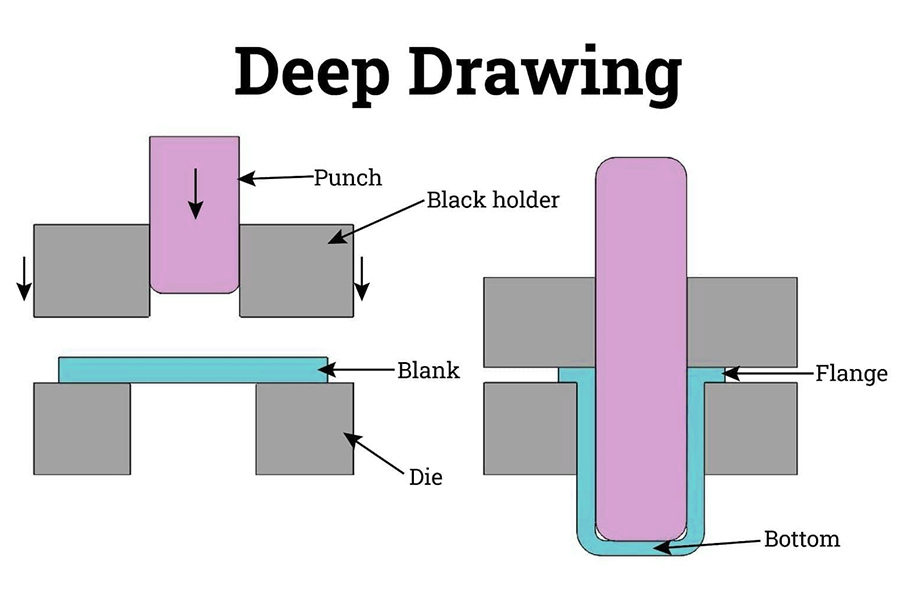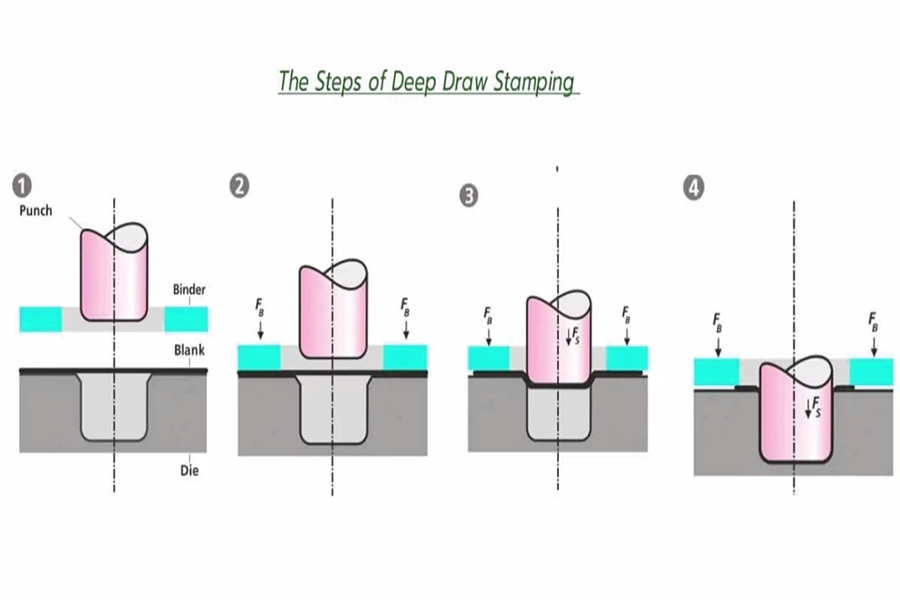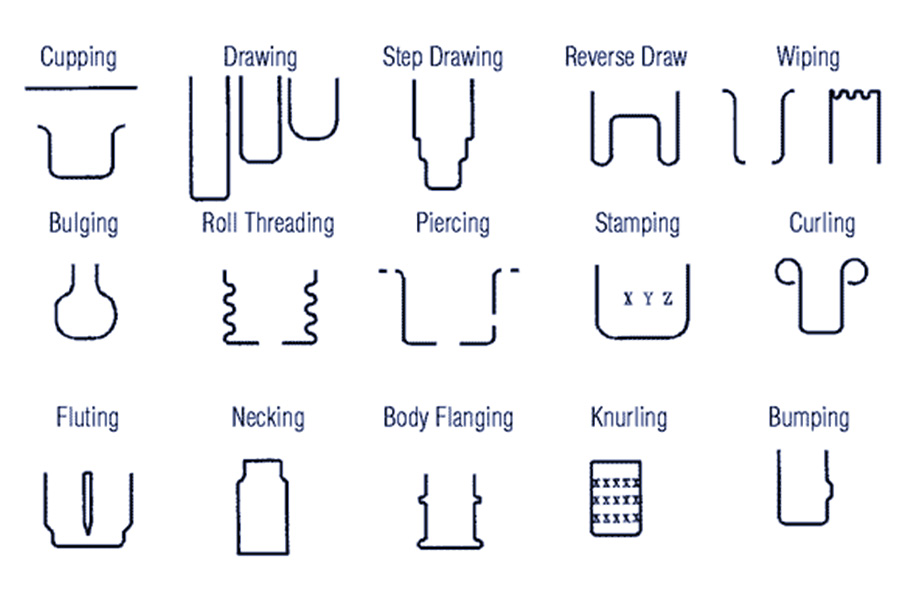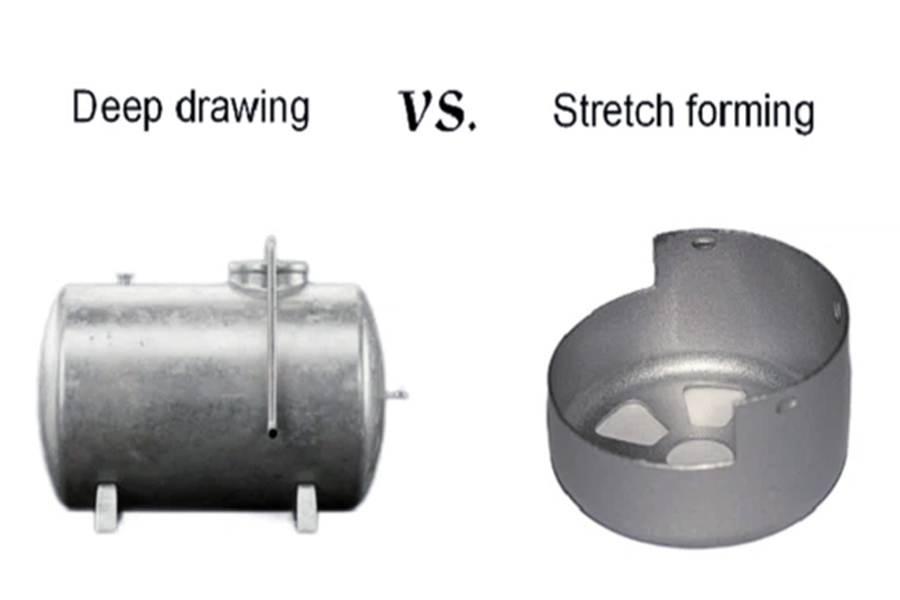Deep drawing stamping is an important metal forming processthat is widely used in the manufacturing industry, especially playing a key role in the production of complex, high-precision metal parts. This process is particularly suitable for producing complex, high-precision metal parts and has a wide range of applications, such as automotive, aerospace, medical, electronics, household appliances and other industries. The working principle and main steps of deep drawing stamping will be introduced in detail below.
What is deep draw stamping?
Deep drawing stampingis a professional deep drawing forming technology that can process flat metal materials into seamless and hollow shapes. Different from other metal forming processes, the deep drawing stamping process guides the metal into the mold cavity and deforms it in a plastic state, thereby creating durable and high-precision bottom closed parts, such as cylinders or various shapes. Different cup-shaped parts. This efficient and precise manufacturing process plays a vital role in many industries, especially those that require extremely high component strength and precision.

How Does deep draw stamping work?
The core idea ofdeep drawing stamping technologyis to use a punch to radially pull a metal sheet (often called a blank) into a forming die, thereby converting the material from a flat plate into a cylindrical or box-shaped hollow component while ensuring that its wall thickness remains stable . During this change, material is transferred from the smooth surface (the flange) to the sides, causing a significant adjustment in the overall dimensions of the flat surface.
How does deep drawing and stamping work step by step?
Deep draw stamping is a metal forming processthat uses a die and press to pull a sheet metal blank radially into a forming die to create a three-dimensional shape. The following is the step-by-step working process of deep drawing and stamping:
- Material preparation:Choose appropriate metal plates as raw materials, such as stainless steel, aluminum, copper or mild steel, etc. Make sure the material is ductile and plastic enough to accommodate deformation during the drawing process.
- Blanking:Use a shear die or blanking die to cut blanks of the desired shape from the raw material. The purpose of blanking is to obtain the shape and size of the blank required for the deep drawing process.
- Sheet centering and cleaning and oiling:For automatic lines, center the sheet to ensure its accurate position. Clean the sheet to remove surface oil and impurities. Apply oil to reduce the friction between the mold and the material and improve the deep drawing effect.
- Deep drawing:Place the blank into thedrawing mold. The blank is stretched through the male and female molds of the mold to form the required three-dimensional shape. Deep drawing is a key process for stamping cover parts, and most of the shape of the cover parts is formed in the drawing process.
- Shaping:Shaping the parts that do not fully meet the requirements after drawing. The main content of the shaping process is to form the shapes that have not been formed in thedrawing processor to correct some shapes with high matching requirements.
- Trimming and punching:Cut off the process supplementary parts and surrounding corner materials on the drawn parts. Punch out the required mounting holes, reference holes, process holes and other holes on the parts.
- Flanging:Flanging the edges of certain parts to form the desired vertical edge shape. Flanging usually follows the trimming process.

What Materials Are Used in Deep Draw Stamping?
Deep drawing stamping is a special metal forming process that uses a wide variety of materials, depending mainly on the characteristics of the desired product, its purpose and cost considerations. Here are somematerials commonly used for deep drawing stamping:
| Material | Characteristics | Applications |
| Low Carbon Steel | High ductility, cost-effective. | Automotive and industrialparts. |
| Stainless Steel | Corrosion resistance, higher strength. | Medical equipment, kitchen sinks. |
| Aluminum | Lightweight, excellent malleability. | Aerospace components, beverage cans. |
| Copper | High conductivity, easy to form. | Electrical components, HVAC systems. |
| Nickel Alloys | High-temperature resistance, excellent corrosion resistance. | Aerospace, chemical processing. |
What are the applications of deep drawing stamping?
Deep drawing stamping is an important metal forming process with wide applications in multiple industries. The following is a detailed summary ofdeep drawing stamping applications:
| Industry | Example Applications |
| Automotive | Fuel tanks, exhaust components, and engine housings. |
| Aerospace | Aircraft fuselage parts, fuel systems, and housings. |
| Medical | Surgical tools, catheter tubes, and defibrillator housings. |
| Consumer Electronics | Smartphone casings, laptop shells, and battery compartments. |
| Home Appliances | Washing machine drums, sink basins, and microwave housings. |
Why is deep drawing stamping so popular among manufacturers?
Thepopularity of deep drawing stampingamong manufacturers is mainly due to its many advantages, which make deep drawing stamping an indispensable part of modern manufacturing. The reasons why deep drawing stamping is popular are:
- High quality products:The deep-drawn stamping parts are made and assisted by molds in the processing process, so the shape and size of the processed products are very accurate. The service life of the die is long, and the deep-drawn stamping parts produced are high-end products in the market.
- Wide range of applications:Deep drawn stamping parts are available in a variety of sizes and are precise in size, which can be applied to many fields of life and industrial production, such as household appliances and automobile manufacturing.
- The production process is simple and easy:From the perspective of the overall control of the process, each step of the production process of deep-drawn stamping parts is controlled like an assembly line, so the complexity of human operation is much simpler than ordinary stamping methods.
- Superior performance:Deep-drawn stamping parts have good performance in terms of tightness and internal strength, which can meet the needs of high-quality products.
- Energy saving and environmental protection:Deep drawing stamping parts have a special manufacturing process, and many materials will be reasonably used in the processing process, and do not require too much energy consumption, saving energy and reducing production costs.

What are the common defects of deep drawing stamping?
Common defects in deep drawing stamping mainly include the following:
1.Crack
This is one of the most common defects in the deep drawing stamping process. It usually occurs in areas where the material is subject to excessive tension or deformation, such as near the punch fillet or the die opening. Rupture may be caused by insufficient material strength, unreasonable mold design, improper stamping process parameters, or poor lubrication.
2.Wrinkling
Wrinkling is caused by uneven tension and pressure on the material during the stamping process, resulting in local material accumulation and instability. Wrinkling usually occurs on flange portions or areas where material flows faster. Wrinkling not only affects the aesthetics of the part, it may also affect its functionality and fitability.
3.Springback
Springback is the shape change of deep-drawn stamped parts due to the elastic recovery of the material after unloading. Springback can cause part dimensions to be inaccurate, shape distortion, or assembly difficulties. The size of springback depends on factors such as the material's elastic modulus, thickness, forming depth, and mold design.

FAQs
1.What is the basic process of deep drawing stamping?
Deep drawing stamping mainly includes: ①Material preparation: Select appropriate metal plates as raw materials, such as stainless steel, aluminum, etc. ② Mold installation: Install the mold (including the punch and concave mold) on the press, and adjust the mold gap and blank holder force. ③Material placement: Place the metal sheet on the blank holder of the mold and press it tightly with the blank holder force. ④ Stamping process: Start the press, the punch moves downward, forcing the material under the blank holder to undergo plastic deformation, flow into the gap between the punch and the concave die, and form a cylindrical side wall and other shapes. ⑤ Workpiece removal: After stamping is completed, take out the formed workpiece and perform necessary inspection and trimming.
How does material deformation occur during deep drawing and stamping?
During the deep drawing and stamping process, the deformation of the material mainly occurs in the flange part. When the punch moves downward, the material of the flange part undergoes plastic deformation under the action of radial tensile stress and tangential compressive stress, and continues to shrink and transform into the cylinder wall. This degree of deformation is greatest at the outermost edge of the flange.
What are the common defects in deep drawing stamping?
Common defects during deep drawing and stamping include wrinkles, tears, springback and surface defects. Wrinkling is a bulging phenomenon that occurs because the tangential compressive stress of the flange part exceeds the material's ability to resist instability; tearing is caused by the material being stretched too thin during the drawing process; springback is a metal The phenomenon of trying to return to its original shape after molding; surface defects may result from unwanted contact of the material with other surfaces, resulting in scratches, marks, or blemishes.
How to avoid defects in deep drawing stamping?
Here are some things you can do to avoid defects in deep drawing stamping: Optimize mold design: A well-designed mold can minimize the occurrence of wrinkling and tearing. Proper lubrication: Using the right lubricant can reduce friction, prevent surface defects, and ensure a smoother stretching process. Choose the right material: It is crucial to choose a material that has consistent properties and is suitable for deep drawing stamping. Slow down the drawing speed: Slowing down the drawing speed can help prevent tearing, especially in more malleable metals. Post-processing: Processes such as annealing help reduce the effects of springback and ensure the metal retains its desired shape.
Summary
Deep drawing stamping is an important metal forming process that radially draws the metal sheet blank into the forming die through a series of dies to form complex three-dimensional shapes. Although some challenges and pitfalls may be encountered during the deep drawing process, these problems can be effectively avoided through measures such as optimizing die design, proper lubrication, selecting appropriate materials, and slowing down the drawing speed. Due to its efficiency, versatility and high quality, deep drawing stamping technology is widely used in many industries and has made important contributions to the development of the manufacturing industry.
Disclaimer
The content on this page is for reference only.LSdoes not make any express or implied representation or warranty as to the accuracy, completeness or validity of the information. No performance parameters, geometric tolerances, specific design features, material quality and type or workmanship should be inferred as to what a third party supplier or manufacturer will deliver through the Longsheng Network. It is the responsibility of the buyerseeking a quote for partsto determine the specific requirements for those parts.Pleasecontact usfor moreinformation.
LS Team
LS is an industry-leading companyspecializing in custom manufacturing solutions. With over 20 years of experience serving more than 5,000 clients, we focus on high-precisionCNC machining,sheet metal fabrication,3D printing,injection molding,metal stamping,and other one-stop manufacturing services.
Our factory is equipped with more than 100 advanced 5-axis machining centers and is ISO 9001:2015 certified. We provide fast, efficient, and high-quality manufacturing solutions to customers in over 150 countries worldwide. Whether it’s low-volume production or large-scale customization, we can meet your needs with delivery as fast as 24 hours. ChoosingLS Technologymeans choosing efficiency, quality, and professionalism.
To learn more, please visit our website:www.lsrpf.com






